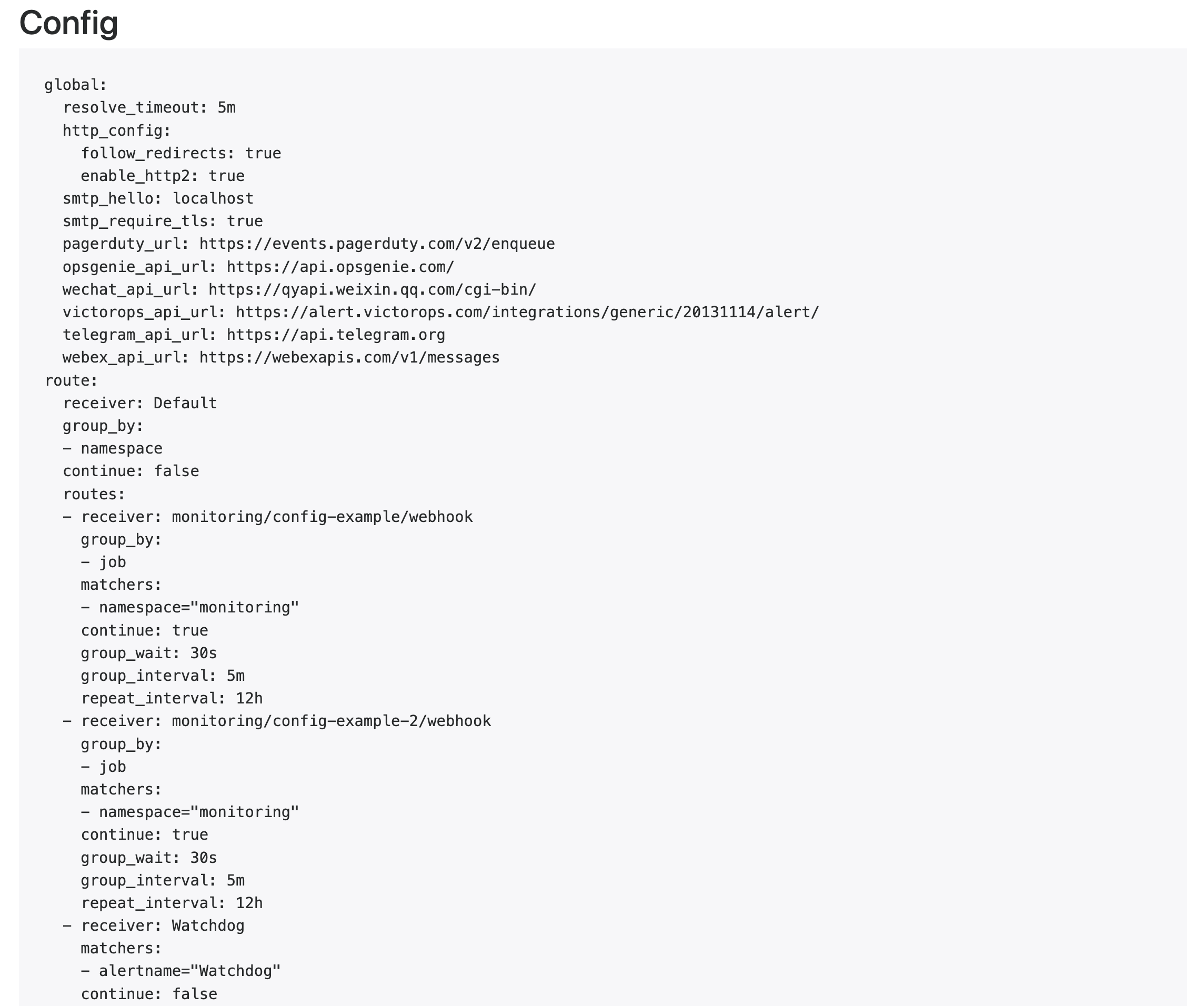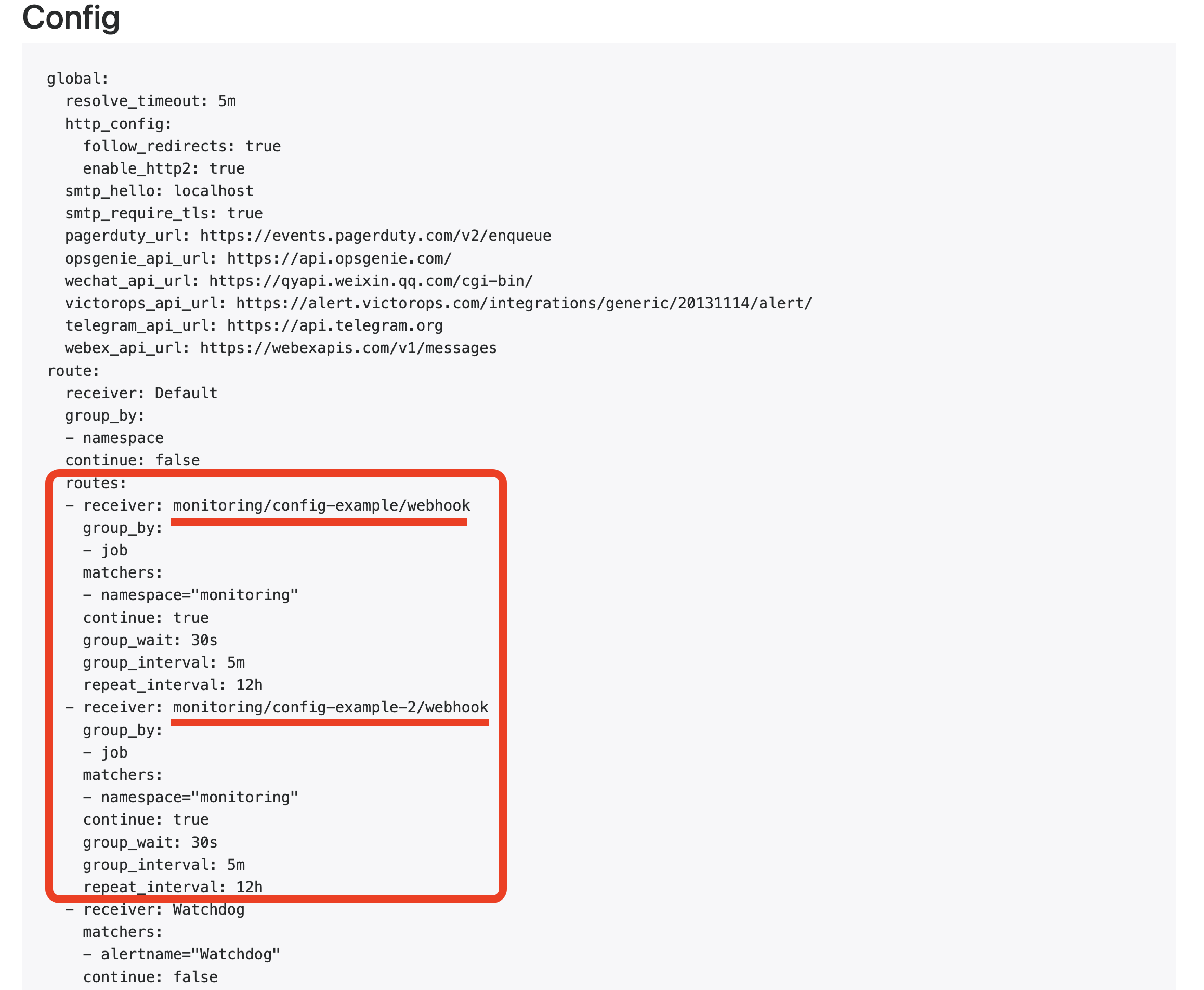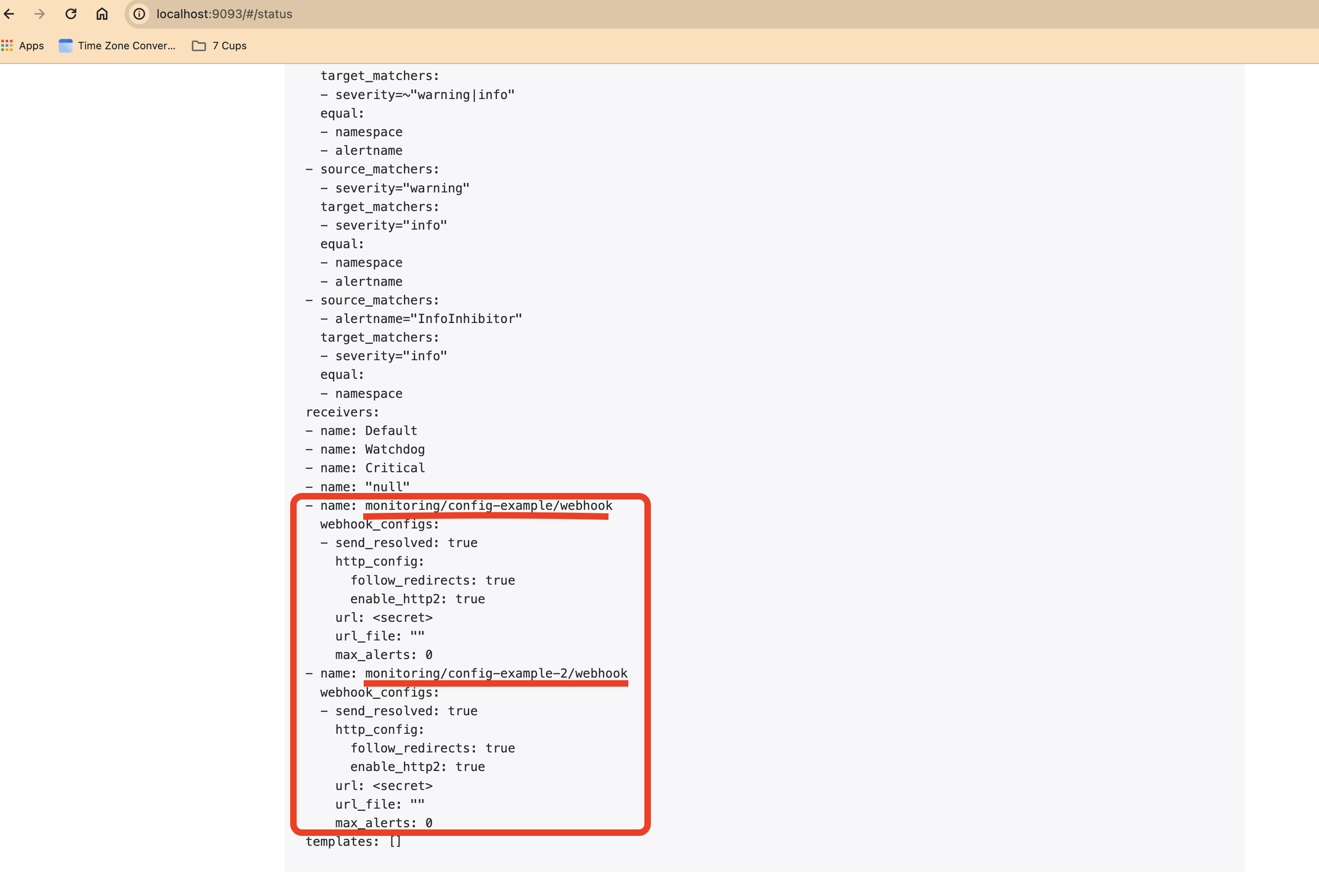Trying out Prometheus Operator's Alertmanager and Alertmanager Config Custom Resources
 Karuppiah Natarajan
Karuppiah Natarajan
In this post, we are going to look at how we can use Alertmanager and AlertmanagerConfig custom resource to create and manage and configure Alertmanager
From https://karuppiah.dev/trying-out-prometheus-operator blog post I showed how to get started with the Prometheus Operator. Follow the same if you haven't. This will kind of be a follow to that blog post
Now, with kube-prometheus installed (from the previous blog post), you will have Alertmanager and AlertmanagerConfig CRDs installed
$ kubectl get crds | rg alertmanager
alertmanagerconfigs.monitoring.coreos.com 2024-05-02T11:16:16Z
alertmanagers.monitoring.coreos.com 2024-05-02T11:16:17Z
Note: I use rg here instead of grep
Let's look at the instances of custom resources for these CRD types
$ kubectl get alertmanagers
No resources found in default namespace.
$ kubectl get alertmanagers --all-namespaces
NAMESPACE NAME VERSION REPLICAS READY RECONCILED AVAILABLE AGE
monitoring main 0.27.0 3 3 True True 74m
$ kubectl get alertmanagerconfig
No resources found in default namespace.
There's just one ☝️1️⃣ Alertmanager defined, which is running the Alertmanager
Let's define some sample configurations for Alertmanager using AlertmanagerConfig
Let's start with some dummy configuration just to test things out. Let's see if we can define two AlertmanagerConfig custom resources and see if it gets merged and configures Alertmanager
# alertmanager-config.yaml
apiVersion: monitoring.coreos.com/v1alpha1
kind: AlertmanagerConfig
metadata:
name: config-example
labels:
alertmanagerConfig: example
spec:
route:
groupBy: ['job']
groupWait: 30s
groupInterval: 5m
repeatInterval: 12h
receiver: 'webhook'
receivers:
- name: 'webhook'
webhookConfigs:
- url: 'http://example.com/'
# alertmanager-second-config.yaml
apiVersion: monitoring.coreos.com/v1alpha1
kind: AlertmanagerConfig
metadata:
name: config-example-2
labels:
alertmanagerConfig: example
spec:
route:
groupBy: ['job']
groupWait: 30s
groupInterval: 5m
repeatInterval: 12h
receiver: 'webhook'
receivers:
- name: 'webhook'
webhookConfigs:
- url: 'http://example.com/'
I'm going to apply these later
I learned the spec of AlertmanagerConfig custom resource using kubectl explain -
$ kubectl explain alertmanagerconfig
GROUP: monitoring.coreos.com
KIND: AlertmanagerConfig
VERSION: v1alpha1
DESCRIPTION:
AlertmanagerConfig configures the Prometheus Alertmanager,
specifying how alerts should be grouped, inhibited and notified to external
systems.
FIELDS:
apiVersion <string>
APIVersion defines the versioned schema of this representation of an object.
Servers should convert recognized schemas to the latest internal value, and
may reject unrecognized values. More info:
https://git.k8s.io/community/contributors/devel/sig-architecture/api-conventions.md#resources
kind <string>
Kind is a string value representing the REST resource this object
represents. Servers may infer this from the endpoint the client submits
requests to. Cannot be updated. In CamelCase. More info:
https://git.k8s.io/community/contributors/devel/sig-architecture/api-conventions.md#types-kinds
metadata <ObjectMeta>
Standard object's metadata. More info:
https://git.k8s.io/community/contributors/devel/sig-architecture/api-conventions.md#metadata
spec <Object> -required-
AlertmanagerConfigSpec is a specification of the desired behavior of the
Alertmanager configuration.
By definition, the Alertmanager configuration only applies to alerts for
which
the `namespace` label is equal to the namespace of the AlertmanagerConfig
resource.
$ kubectl explain alertmanagerconfig.spec
GROUP: monitoring.coreos.com
KIND: AlertmanagerConfig
VERSION: v1alpha1
FIELD: spec <Object>
DESCRIPTION:
AlertmanagerConfigSpec is a specification of the desired behavior of the
Alertmanager configuration.
By definition, the Alertmanager configuration only applies to alerts for
which
the `namespace` label is equal to the namespace of the AlertmanagerConfig
resource.
FIELDS:
inhibitRules <[]Object>
List of inhibition rules. The rules will only apply to alerts matching
the resource's namespace.
muteTimeIntervals <[]Object>
List of MuteTimeInterval specifying when the routes should be muted.
receivers <[]Object>
List of receivers.
route <Object>
The Alertmanager route definition for alerts matching the resource's
namespace. If present, it will be added to the generated Alertmanager
configuration as a first-level route.
Now let's look at how to configure Alertmanager using the AlertmanagerConfig custom resource
You can read how to configure Alertmanager in general, and how Alertmanager and AlertmanagerConfig are related to each other from the following official docs -
https://prometheus-operator.dev/docs/user-guides/alerting/#managing-alertmanager-configuration
https://prometheus-operator.dev/docs/user-guides/alerting/#using-alertmanagerconfig-resources
Since I'm trying to merge the two AlertmanagerConfig custom resources into one, I'll be following the doc - https://prometheus-operator.dev/docs/user-guides/alerting/#using-alertmanagerconfig-resources
I'll be defining spec.alertmanagerConfigSelector of Alertmanager. This is how the Prometheus Operator will be able to connect that a particular AlertmanagerConfig belongs to one or more Alertmanagers. Yes, you read that right, since AlertmanagerConfig is a standalone thing and Alertmanager only tells which AlertmanagerConfig to select using the spec.alertmanagerConfigSelector, multiple Alertmanager custom resources can point to the same set of AlertmanagerConfig. How cool is that? 😁😄😃😀 This way, you can reuse AlertmanagerConfig and configure multiple Alertmanagers too, in case you want to :)
Again, you can use kubectl explain to look at the spec of Alertmanager custom resource
$ kubectl explain alertmanager
...
$ kubectl explain alertmanager.spec
...
$ kubectl explain alertmanager.spec.alertmanagerConfigSelector
...
$ kubectl explain alertmanager.spec.alertmanagerConfigSelector
GROUP: monitoring.coreos.com
KIND: Alertmanager
VERSION: v1
FIELD: alertmanagerConfigSelector <Object>
DESCRIPTION:
AlertmanagerConfigs to be selected for to merge and configure Alertmanager
with.
FIELDS:
matchExpressions <[]Object>
matchExpressions is a list of label selector requirements. The requirements
are ANDed.
matchLabels <map[string]string>
matchLabels is a map of {key,value} pairs. A single {key,value} in the
matchLabels
map is equivalent to an element of matchExpressions, whose key field is
"key", the
operator is "In", and the values array contains only "value". The
requirements are ANDed.
Both my AlertmanagerConfigs have the label alertmanagerConfig: example, so I can use the following in Alertmanager's spec
spec:
alertmanagerConfigSelector:
matchLabels:
alertmanagerConfig: example
Before doing the change, I'm gonna keep a watch on my logs -
You can look at the Prometheus Operator logs, and Alertmanager logs, all using stern , something like this -
$ stern -n monitoring prometheus-operator
$ stern -n monitoring alertmanager-main-*
You will see logs after your change.
For the change, this is how I did it -
$ kubectl edit alertmanager -n monitoring main
And this is how I changed the YAML -
# Please edit the object below. Lines beginning with a '#' will be ignored,
# and an empty file will abort the edit. If an error occurs while saving this file will be
# reopened with the relevant failures.
#
apiVersion: monitoring.coreos.com/v1
kind: Alertmanager
metadata:
creationTimestamp: "2024-05-02T11:17:20Z"
generation: 1
labels:
app.kubernetes.io/component: alert-router
app.kubernetes.io/instance: main
app.kubernetes.io/name: alertmanager
app.kubernetes.io/part-of: kube-prometheus
app.kubernetes.io/version: 0.27.0
name: main
namespace: monitoring
resourceVersion: "1570"
uid: 33fb19f8-6512-4206-b9f2-24f646c0ae46
spec:
alertmanagerConfigSelector:
matchLabels:
alertmanagerConfig: example
image: quay.io/prometheus/alertmanager:v0.27.0
nodeSelector:
kubernetes.io/os: linux
podMetadata:
labels:
app.kubernetes.io/component: alert-router
app.kubernetes.io/instance: main
app.kubernetes.io/name: alertmanager
app.kubernetes.io/part-of: kube-prometheus
app.kubernetes.io/version: 0.27.0
portName: web
replicas: 3
resources:
limits:
cpu: 100m
memory: 100Mi
requests:
cpu: 4m
memory: 100Mi
retention: 120h
secrets: []
securityContext:
fsGroup: 2000
runAsNonRoot: true
runAsUser: 1000
serviceAccountName: alertmanager-main
version: 0.27.0
status:
availableReplicas: 3
conditions:
- lastTransitionTime: "2024-05-02T11:19:25Z"
message: ""
observedGeneration: 1
reason: ""
status: "True"
type: Available
- lastTransitionTime: "2024-05-02T11:18:31Z"
message: ""
observedGeneration: 1
reason: ""
status: "True"
type: Reconciled
paused: false
replicas: 3
unavailableReplicas: 0
updatedReplicas: 3
And then saved it
Now I'm going to apply the Alertmanager configurations
$ kubectl apply -n monitoring -f /Users/karuppiah.n/every-day-log/alertmanager-config.yaml
alertmanagerconfig.monitoring.coreos.com/config-example created
$ kubectl apply -n monitoring -f /Users/karuppiah.n/every-day-log/alertmanager-second-config.yaml
alertmanagerconfig.monitoring.coreos.com/config-example-2 created
When the above configurations are applied, you will notice that the config-reloader sidecar containers in all the Alertmanager instances will have a Reload triggered log, and Alertmanager's main container / server container have Loading configuration file log and Completed loading of configuration file, like this -
alertmanager-main-2 alertmanager ts=2024-05-02T14:58:22.958Z caller=coordinator.go:113 level=info component=configuration msg="Loading configuration file" file=/etc/alertmanager/config_out/alertmanager.env.yaml
alertmanager-main-2 alertmanager ts=2024-05-02T14:58:22.960Z caller=coordinator.go:126 level=info component=configuration msg="Completed loading of configuration file" file=/etc/alertmanager/config_out/alertmanager.env.yaml
alertmanager-main-2 config-reloader level=info ts=2024-05-02T14:58:22.964016458Z caller=reloader.go:424 msg="Reload triggered" cfg_in=/etc/alertmanager/config/alertmanager.yaml.gz cfg_out=/etc/alertmanager/config_out/alertmanager.env.yaml watched_dirs=/etc/alertmanager/config
alertmanager-main-1 alertmanager ts=2024-05-02T14:58:27.754Z caller=coordinator.go:113 level=info component=configuration msg="Loading configuration file" file=/etc/alertmanager/config_out/alertmanager.env.yaml
alertmanager-main-1 alertmanager ts=2024-05-02T14:58:27.755Z caller=coordinator.go:126 level=info component=configuration msg="Completed loading of configuration file" file=/etc/alertmanager/config_out/alertmanager.env.yaml
alertmanager-main-1 config-reloader level=info ts=2024-05-02T14:58:27.954138209Z caller=reloader.go:424 msg="Reload triggered" cfg_in=/etc/alertmanager/config/alertmanager.yaml.gz cfg_out=/etc/alertmanager/config_out/alertmanager.env.yaml watched_dirs=/etc/alertmanager/config
alertmanager-main-0 alertmanager ts=2024-05-02T14:58:39.058Z caller=coordinator.go:113 level=info component=configuration msg="Loading configuration file" file=/etc/alertmanager/config_out/alertmanager.env.yaml
alertmanager-main-0 alertmanager ts=2024-05-02T14:58:39.059Z caller=coordinator.go:126 level=info component=configuration msg="Completed loading of configuration file" file=/etc/alertmanager/config_out/alertmanager.env.yaml
alertmanager-main-0 config-reloader level=info ts=2024-05-02T14:58:39.062383067Z caller=reloader.go:424 msg="Reload triggered" cfg_in=/etc/alertmanager/config/alertmanager.yaml.gz cfg_out=/etc/alertmanager/config_out/alertmanager.env.yaml watched_dirs=/etc/alertmanager/config
Now, if I port forward Alertmanager's Web UI port and checkout the Alertmanager Configuration in the Web UI, I'll see this -

Notice how it says config-example based on the name of the AlertmanagerConfig custom resource name :)

That is in the routes list, we can see the same in the receivers list -

So, this way, it's clear that one can create multiple AlertmanagerConfigs and they can all be merged to one Alertmanager Configuration
Let's also try using a global Alertmanager Configuration using Alertmanager custom resource's spec.alertmanagerConfiguration, where we can mention the name of the AlertmanagerConfiguration custom resource instance's name in spec.alertmanagerConfiguration.name and there are more fields under spec.alertmanagerConfiguration like global, templates
$ kubectl explain alertmanager.spec.alertmanagerConfiguration
GROUP: monitoring.coreos.com
KIND: Alertmanager
VERSION: v1
FIELD: alertmanagerConfiguration <Object>
DESCRIPTION:
alertmanagerConfiguration specifies the configuration of Alertmanager.
If defined, it takes precedence over the `configSecret` field.
This is an *experimental feature*, it may change in any upcoming release
in a breaking way.
FIELDS:
global <Object>
Defines the global parameters of the Alertmanager configuration.
name <string>
The name of the AlertmanagerConfig resource which is used to generate the
Alertmanager configuration.
It must be defined in the same namespace as the Alertmanager object.
The operator will not enforce a `namespace` label for routes and inhibition
rules.
templates <[]Object>
Custom notification templates.
$ kubectl explain alertmanager.spec.alertmanagerConfiguration.global
GROUP: monitoring.coreos.com
KIND: Alertmanager
VERSION: v1
FIELD: global <Object>
DESCRIPTION:
Defines the global parameters of the Alertmanager configuration.
FIELDS:
httpConfig <Object>
HTTP client configuration.
opsGenieApiKey <Object>
The default OpsGenie API Key.
opsGenieApiUrl <Object>
The default OpsGenie API URL.
pagerdutyUrl <string>
The default Pagerduty URL.
resolveTimeout <string>
ResolveTimeout is the default value used by alertmanager if the alert does
not include EndsAt, after this time passes it can declare the alert as
resolved if it has not been updated.
This has no impact on alerts from Prometheus, as they always include EndsAt.
slackApiUrl <Object>
The default Slack API URL.
smtp <Object>
Configures global SMTP parameters.
$ kubectl explain alertmanager.spec.alertmanagerConfiguration.templates
GROUP: monitoring.coreos.com
KIND: Alertmanager
VERSION: v1
FIELD: templates <[]Object>
DESCRIPTION:
Custom notification templates.
SecretOrConfigMap allows to specify data as a Secret or ConfigMap. Fields
are mutually exclusive.
FIELDS:
configMap <Object>
ConfigMap containing data to use for the targets.
secret <Object>
Secret containing data to use for the targets.
Let's use the global Alertmanager Configuration along with the existing separate Alertmanager Configurations we have, which are scattered across AlertmanagerConfig custom resource instances, and see if we get a completely merged Alertmanager Configuration
I'm going to use the following dummy global Alertmanager Configuration -
# alertmanager-global-config.yaml
apiVersion: monitoring.coreos.com/v1alpha1
kind: AlertmanagerConfig
metadata:
name: config-example-global
spec:
route:
groupBy: ['job']
groupWait: 25s
groupInterval: 6m
repeatInterval: 13h
receiver: 'secret-webhook'
receivers:
- name: 'secret-webhook'
webhookConfigs:
- url: 'http://random-example.com/'
Keep your Prometheus Operator's Logs streaming, Alertmanager's Logs (server, config-reloader sidecar) streaming, all using stern or similar tool (kubectl logs etc)
And then first apply the AlertmanagerConfig custom resource instance which is required to mention in the Alertmanager custom resource instance. Remember to create it in the same namespace as the Alertmanager custom resource instance!
$ kubectl apply -n monitoring -f /Users/karuppiah.n/every-day-log/alertmanager-global-config.yaml
alertmanagerconfig.monitoring.coreos.com/config-example-global created
Finally, mention the name of the AlertmanagerConfig in the Alertmanager custom resource instance under spec.alertmanagerConfiguration.name like this -
$ kubectl edit alertmanager -n monitoring main
My Alertmanager custom resource instance looks like this now after the edit -
# Please edit the object below. Lines beginning with a '#' will be ignored,
# and an empty file will abort the edit. If an error occurs while saving this file will be
# reopened with the relevant failures.
#
apiVersion: monitoring.coreos.com/v1
kind: Alertmanager
metadata:
creationTimestamp: "2024-05-02T11:17:20Z"
generation: 3
labels:
app.kubernetes.io/component: alert-router
app.kubernetes.io/instance: main
app.kubernetes.io/name: alertmanager
app.kubernetes.io/part-of: kube-prometheus
app.kubernetes.io/version: 0.27.0
name: main
namespace: monitoring
resourceVersion: "40052"
uid: 33fb19f8-6512-4206-b9f2-24f646c0ae46
spec:
alertmanagerConfigSelector:
matchLabels:
alertmanagerConfig: example
alertmanagerConfiguration:
name: config-example-global
image: quay.io/prometheus/alertmanager:v0.27.0
nodeSelector:
kubernetes.io/os: linux
podMetadata:
labels:
app.kubernetes.io/component: alert-router
app.kubernetes.io/instance: main
app.kubernetes.io/name: alertmanager
app.kubernetes.io/part-of: kube-prometheus
app.kubernetes.io/version: 0.27.0
portName: web
replicas: 3
resources:
limits:
cpu: 100m
memory: 100Mi
requests:
cpu: 4m
memory: 100Mi
retention: 120h
secrets: []
securityContext:
fsGroup: 2000
runAsNonRoot: true
runAsUser: 1000
serviceAccountName: alertmanager-main
version: 0.27.0
status:
availableReplicas: 3
conditions:
- lastTransitionTime: "2024-05-07T14:49:46Z"
message: ""
observedGeneration: 3
reason: ""
status: "True"
type: Available
- lastTransitionTime: "2024-05-07T14:21:05Z"
message: ""
observedGeneration: 3
reason: ""
status: "True"
type: Reconciled
paused: false
replicas: 3
unavailableReplicas: 0
updatedReplicas: 3
Notice the spec.alertmanagerConfiguration.name being config-example-global
You will notice Prometheus Operator logs after this change and also logs in the Alertmanager config-reloader sidecar
If you port forward to the Alertmanager Kubernetes service, then you can see how the Alertmanager Configuration has changed and show all the configurations we have -
$ kubectl --namespace monitoring port-forward svc/alertmanager-main 9093
Forwarding from 127.0.0.1:9093 -> 9093
Forwarding from [::1]:9093 -> 9093
Handling connection for 9093
Handling connection for 9093
Handling connection for 9093
Handling connection for 9093
Now the Alertmanager Configuration looks like this -
global:
resolve_timeout: 5m
http_config:
follow_redirects: true
enable_http2: true
smtp_hello: localhost
smtp_require_tls: true
pagerduty_url: https://events.pagerduty.com/v2/enqueue
opsgenie_api_url: https://api.opsgenie.com/
wechat_api_url: https://qyapi.weixin.qq.com/cgi-bin/
victorops_api_url: https://alert.victorops.com/integrations/generic/20131114/alert/
telegram_api_url: https://api.telegram.org
webex_api_url: https://webexapis.com/v1/messages
route:
receiver: monitoring/config-example-global/secret-webhook
group_by:
- job
continue: false
routes:
- receiver: monitoring/config-example/webhook
group_by:
- job
matchers:
- namespace="monitoring"
continue: true
group_wait: 30s
group_interval: 5m
repeat_interval: 12h
- receiver: monitoring/config-example-2/webhook
group_by:
- job
matchers:
- namespace="monitoring"
continue: true
group_wait: 30s
group_interval: 5m
repeat_interval: 12h
group_wait: 25s
group_interval: 6m
repeat_interval: 13h
receivers:
- name: monitoring/config-example-global/secret-webhook
webhook_configs:
- send_resolved: true
http_config:
follow_redirects: true
enable_http2: true
url: <secret>
url_file: ""
max_alerts: 0
- name: monitoring/config-example/webhook
webhook_configs:
- send_resolved: true
http_config:
follow_redirects: true
enable_http2: true
url: <secret>
url_file: ""
max_alerts: 0
- name: monitoring/config-example-2/webhook
webhook_configs:
- send_resolved: true
http_config:
follow_redirects: true
enable_http2: true
url: <secret>
url_file: ""
max_alerts: 0
templates: []
If you notice, there's top level route with the receiver we have mentioned in the global configuration and the group_by, group_wait, group_interval, repeat_interval, and the config-example-global receiver is also defined in the receivers section - name: monitoring/config-example-global/secret-webhook.
Also, one important thing to note is, how the casing in of the fields in the Kubernetes custom resource is different from the casing of the fields in the actual Alertmanager Configuration. For example,
group_by in Alertmanger Configuration YAML vs groupBy in AlertmanagerConfig Kubernetes custom resource
group_wait in Alertmanger Configuration YAML vs groupWait in AlertmanagerConfig Kubernetes custom resource
group_interval in Alertmanger Configuration YAML vs groupInterval in AlertmanagerConfig Kubernetes custom resource
repeat_interval in Alertmanger Configuration YAML vs repeatInterval in AlertmanagerConfig Kubernetes custom resource
So, be careful when creating the AlertmanagerConfig Kubernetes custom resource instance YAMLs and any related Kubernetes custom resource instance YAMLs. Look at the kubectl explain <resource-type-name> documentation
Note that kubectl explain <resource-type-name> works only against a live running Kubernetes cluster which has the resource type mentioned in the argument, which could be a built-in resource or a custom resource
To check if a resource type exists in the Kubernetes cluster, just use one of the following -
$ kubectl get <resource-type-name>
$ kubectl api-resources | grep --color --ignore-case <resource-type-name>
$ # if it's a CRD
$ kubectl get crd | grep --color --ignore-case <resource-type-name>
That's all I had for this blog post. You can also check how to provide Alertmanager Configuration using Kubernetes Secrets, either using the convention that the Prometheus Operator follows alertmanager-<name-of-alertmanager-custom-resource-instance>, follow - https://prometheus-operator.dev/docs/user-guides/alerting/#using-a-kubernetes-secret . Or else use the spec.configSecret field of the Alertmanager custom resource
$ kubectl explain alertmanager.spec.configSecret
GROUP: monitoring.coreos.com
KIND: Alertmanager
VERSION: v1
FIELD: configSecret <string>
DESCRIPTION:
ConfigSecret is the name of a Kubernetes Secret in the same namespace as the
Alertmanager object, which contains the configuration for this Alertmanager
instance. If empty, it defaults to `alertmanager-<alertmanager-name>`.
The Alertmanager configuration should be available under the
`alertmanager.yaml` key. Additional keys from the original secret are
copied to the generated secret and mounted into the
`/etc/alertmanager/config` directory in the `alertmanager` container.
If either the secret or the `alertmanager.yaml` key is missing, the
operator provisions a minimal Alertmanager configuration with one empty
receiver (effectively dropping alert notifications).
In my case, somehow the Kubernetes secret was already there 🤔🤨🧐. I'm not sure how. It's an unknown for me. I'll read more about it and maybe write ✍️🖋️✒️🖊️✏️ about it later, in another blog post. Here's what I found out -
$ kubectl get secret -n monitoring
NAME TYPE DATA AGE
alertmanager-main Opaque 1 5d6h
alertmanager-main-generated Opaque 1 5d6h
alertmanager-main-tls-assets-0 Opaque 0 5d6h
alertmanager-main-web-config Opaque 1 5d6h
grafana-config Opaque 1 5d6h
grafana-datasources Opaque 1 5d6h
prometheus-k8s Opaque 1 5d6h
prometheus-k8s-tls-assets-0 Opaque 0 5d6h
prometheus-k8s-web-config Opaque 1 5d6h
$ kubectl get secret -n monitoring alertmanager-main
NAME TYPE DATA AGE
alertmanager-main Opaque 1 5d6h
$ kubectl get secret -n monitoring alertmanager-main -o yaml
apiVersion: v1
data:
alertmanager.yaml: Imdsb2JhbCI6CiAgInJlc29sdmVfdGltZW91dCI6ICI1bSIKImluaGliaXRfcnVsZXMiOgotICJlcXVhbCI6CiAgLSAibmFtZXNwYWNlIgogIC0gImFsZXJ0bmFtZSIKICAic291cmNlX21hdGNoZXJzIjoKICAtICJzZXZlcml0eSA9IGNyaXRpY2FsIgogICJ0YXJnZXRfbWF0Y2hlcnMiOgogIC0gInNldmVyaXR5ID1+IHdhcm5pbmd8aW5mbyIKLSAiZXF1YWwiOgogIC0gIm5hbWVzcGFjZSIKICAtICJhbGVydG5hbWUiCiAgInNvdXJjZV9tYXRjaGVycyI6CiAgLSAic2V2ZXJpdHkgPSB3YXJuaW5nIgogICJ0YXJnZXRfbWF0Y2hlcnMiOgogIC0gInNldmVyaXR5ID0gaW5mbyIKLSAiZXF1YWwiOgogIC0gIm5hbWVzcGFjZSIKICAic291cmNlX21hdGNoZXJzIjoKICAtICJhbGVydG5hbWUgPSBJbmZvSW5oaWJpdG9yIgogICJ0YXJnZXRfbWF0Y2hlcnMiOgogIC0gInNldmVyaXR5ID0gaW5mbyIKInJlY2VpdmVycyI6Ci0gIm5hbWUiOiAiRGVmYXVsdCIKLSAibmFtZSI6ICJXYXRjaGRvZyIKLSAibmFtZSI6ICJDcml0aWNhbCIKLSAibmFtZSI6ICJudWxsIgoicm91dGUiOgogICJncm91cF9ieSI6CiAgLSAibmFtZXNwYWNlIgogICJncm91cF9pbnRlcnZhbCI6ICI1bSIKICAiZ3JvdXBfd2FpdCI6ICIzMHMiCiAgInJlY2VpdmVyIjogIkRlZmF1bHQiCiAgInJlcGVhdF9pbnRlcnZhbCI6ICIxMmgiCiAgInJvdXRlcyI6CiAgLSAibWF0Y2hlcnMiOgogICAgLSAiYWxlcnRuYW1lID0gV2F0Y2hkb2ciCiAgICAicmVjZWl2ZXIiOiAiV2F0Y2hkb2ciCiAgLSAibWF0Y2hlcnMiOgogICAgLSAiYWxlcnRuYW1lID0gSW5mb0luaGliaXRvciIKICAgICJyZWNlaXZlciI6ICJudWxsIgogIC0gIm1hdGNoZXJzIjoKICAgIC0gInNldmVyaXR5ID0gY3JpdGljYWwiCiAgICAicmVjZWl2ZXIiOiAiQ3JpdGljYWwi
kind: Secret
metadata:
creationTimestamp: "2024-05-02T11:17:20Z"
labels:
app.kubernetes.io/component: alert-router
app.kubernetes.io/instance: main
app.kubernetes.io/name: alertmanager
app.kubernetes.io/part-of: kube-prometheus
app.kubernetes.io/version: 0.27.0
name: alertmanager-main
namespace: monitoring
resourceVersion: "880"
uid: 59ff212e-f2af-48eb-a19e-ba0f69246dce
type: Opaque
$ kubectl get secret -n monitoring alertmanager-main -o jsonpath='{.data.alertmanager\.yaml}'
Imdsb2JhbCI6CiAgInJlc29sdmVfdGltZW91dCI6ICI1bSIKImluaGliaXRfcnVsZXMiOgotICJlcXVhbCI6CiAgLSAibmFtZXNwYWNlIgogIC0gImFsZXJ0bmFtZSIKICAic291cmNlX21hdGNoZXJzIjoKICAtICJzZXZlcml0eSA9IGNyaXRpY2FsIgogICJ0YXJnZXRfbWF0Y2hlcnMiOgogIC0gInNldmVyaXR5ID1+IHdhcm5pbmd8aW5mbyIKLSAiZXF1YWwiOgogIC0gIm5hbWVzcGFjZSIKICAtICJhbGVydG5hbWUiCiAgInNvdXJjZV9tYXRjaGVycyI6CiAgLSAic2V2ZXJpdHkgPSB3YXJuaW5nIgogICJ0YXJnZXRfbWF0Y2hlcnMiOgogIC0gInNldmVyaXR5ID0gaW5mbyIKLSAiZXF1YWwiOgogIC0gIm5hbWVzcGFjZSIKICAic291cmNlX21hdGNoZXJzIjoKICAtICJhbGVydG5hbWUgPSBJbmZvSW5oaWJpdG9yIgogICJ0YXJnZXRfbWF0Y2hlcnMiOgogIC0gInNldmVyaXR5ID0gaW5mbyIKInJlY2VpdmVycyI6Ci0gIm5hbWUiOiAiRGVmYXVsdCIKLSAibmFtZSI6ICJXYXRjaGRvZyIKLSAibmFtZSI6ICJDcml0aWNhbCIKLSAibmFtZSI6ICJudWxsIgoicm91dGUiOgogICJncm91cF9ieSI6CiAgLSAibmFtZXNwYWNlIgogICJncm91cF9pbnRlcnZhbCI6ICI1bSIKICAiZ3JvdXBfd2FpdCI6ICIzMHMiCiAgInJlY2VpdmVyIjogIkRlZmF1bHQiCiAgInJlcGVhdF9pbnRlcnZhbCI6ICIxMmgiCiAgInJvdXRlcyI6CiAgLSAibWF0Y2hlcnMiOgogICAgLSAiYWxlcnRuYW1lID0gV2F0Y2hkb2ciCiAgICAicmVjZWl2ZXIiOiAiV2F0Y2hkb2ciCiAgLSAibWF0Y2hlcnMiOgogICAgLSAiYWxlcnRuYW1lID0gSW5mb0luaGliaXRvciIKICAgICJyZWNlaXZlciI6ICJudWxsIgogIC0gIm1hdGNoZXJzIjoKICAgIC0gInNldmVyaXR5ID0gY3JpdGljYWwiCiAgICAicmVjZWl2ZXIiOiAiQ3JpdGljYWwi
$ kubectl get secret -n monitoring alertmanager-main -o jsonpath='{.data.alertmanager\.yaml}' | base64 --decode
"global":
"resolve_timeout": "5m"
"inhibit_rules":
- "equal":
- "namespace"
- "alertname"
"source_matchers":
- "severity = critical"
"target_matchers":
- "severity =~ warning|info"
- "equal":
- "namespace"
- "alertname"
"source_matchers":
- "severity = warning"
"target_matchers":
- "severity = info"
- "equal":
- "namespace"
"source_matchers":
- "alertname = InfoInhibitor"
"target_matchers":
- "severity = info"
"receivers":
- "name": "Default"
- "name": "Watchdog"
- "name": "Critical"
- "name": "null"
"route":
"group_by":
- "namespace"
"group_interval": "5m"
"group_wait": "30s"
"receiver": "Default"
"repeat_interval": "12h"
"routes":
- "matchers":
- "alertname = Watchdog"
"receiver": "Watchdog"
- "matchers":
- "alertname = InfoInhibitor"
"receiver": "null"
- "matchers":
- "severity = critical"
"receiver": "Critical"
So, that's the Alertmanager Configuration I found in the Kubernetes Secret. I have no idea how it got there as a Kubernetes Secret, what put it, why etc. Something to read and learn
Anyways, that's all I had to talk about :) As a last note, you can check the full spec of Alertmanager custom resource definition and also AlertmanagerConfig custom resource definition. I'm attaching Alertmanager's custom resource definition's full spec below ⬇️👇
Full spec for Alertmanager as of this writing for the given version of Prometheus Operator and Alertmanager custom resource definition -
$ kubectl explain alertmanager.spec
GROUP: monitoring.coreos.com
KIND: Alertmanager
VERSION: v1
FIELD: spec <Object>
DESCRIPTION:
Specification of the desired behavior of the Alertmanager cluster. More
info:
https://github.com/kubernetes/community/blob/master/contributors/devel/sig-architecture/api-conventions.md#spec-and-status
FIELDS:
additionalPeers <[]string>
AdditionalPeers allows injecting a set of additional Alertmanagers to peer
with to form a highly available cluster.
affinity <Object>
If specified, the pod's scheduling constraints.
alertmanagerConfigMatcherStrategy <Object>
The AlertmanagerConfigMatcherStrategy defines how AlertmanagerConfig objects
match the alerts.
In the future more options may be added.
alertmanagerConfigNamespaceSelector <Object>
Namespaces to be selected for AlertmanagerConfig discovery. If nil, only
check own namespace.
alertmanagerConfigSelector <Object>
AlertmanagerConfigs to be selected for to merge and configure Alertmanager
with.
alertmanagerConfiguration <Object>
alertmanagerConfiguration specifies the configuration of Alertmanager.
If defined, it takes precedence over the `configSecret` field.
This is an *experimental feature*, it may change in any upcoming release
in a breaking way.
automountServiceAccountToken <boolean>
AutomountServiceAccountToken indicates whether a service account token
should be automatically mounted in the pod.
If the service account has `automountServiceAccountToken: true`, set the
field to `false` to opt out of automounting API credentials.
baseImage <string>
Base image that is used to deploy pods, without tag.
Deprecated: use 'image' instead.
clusterAdvertiseAddress <string>
ClusterAdvertiseAddress is the explicit address to advertise in cluster.
Needs to be provided for non RFC1918 [1] (public) addresses.
[1] RFC1918: https://tools.ietf.org/html/rfc1918
clusterGossipInterval <string>
Interval between gossip attempts.
clusterLabel <string>
Defines the identifier that uniquely identifies the Alertmanager cluster.
You should only set it when the Alertmanager cluster includes Alertmanager
instances which are external to this Alertmanager resource. In practice, the
addresses of the external instances are provided via the
`.spec.additionalPeers` field.
clusterPeerTimeout <string>
Timeout for cluster peering.
clusterPushpullInterval <string>
Interval between pushpull attempts.
configMaps <[]string>
ConfigMaps is a list of ConfigMaps in the same namespace as the Alertmanager
object, which shall be mounted into the Alertmanager Pods.
Each ConfigMap is added to the StatefulSet definition as a volume named
`configmap-<configmap-name>`.
The ConfigMaps are mounted into
`/etc/alertmanager/configmaps/<configmap-name>` in the 'alertmanager'
container.
configSecret <string>
ConfigSecret is the name of a Kubernetes Secret in the same namespace as the
Alertmanager object, which contains the configuration for this Alertmanager
instance. If empty, it defaults to `alertmanager-<alertmanager-name>`.
The Alertmanager configuration should be available under the
`alertmanager.yaml` key. Additional keys from the original secret are
copied to the generated secret and mounted into the
`/etc/alertmanager/config` directory in the `alertmanager` container.
If either the secret or the `alertmanager.yaml` key is missing, the
operator provisions a minimal Alertmanager configuration with one empty
receiver (effectively dropping alert notifications).
containers <[]Object>
Containers allows injecting additional containers. This is meant to
allow adding an authentication proxy to an Alertmanager pod.
Containers described here modify an operator generated container if they
share the same name and modifications are done via a strategic merge
patch. The current container names are: `alertmanager` and
`config-reloader`. Overriding containers is entirely outside the scope
of what the maintainers will support and by doing so, you accept that
this behaviour may break at any time without notice.
enableFeatures <[]string>
Enable access to Alertmanager feature flags. By default, no features are
enabled.
Enabling features which are disabled by default is entirely outside the
scope of what the maintainers will support and by doing so, you accept
that this behaviour may break at any time without notice.
It requires Alertmanager >= 0.27.0.
externalUrl <string>
The external URL the Alertmanager instances will be available under. This is
necessary to generate correct URLs. This is necessary if Alertmanager is not
served from root of a DNS name.
forceEnableClusterMode <boolean>
ForceEnableClusterMode ensures Alertmanager does not deactivate the cluster
mode when running with a single replica.
Use case is e.g. spanning an Alertmanager cluster across Kubernetes clusters
with a single replica in each.
hostAliases <[]Object>
Pods' hostAliases configuration
image <string>
Image if specified has precedence over baseImage, tag and sha
combinations. Specifying the version is still necessary to ensure the
Prometheus Operator knows what version of Alertmanager is being
configured.
imagePullPolicy <string>
Image pull policy for the 'alertmanager', 'init-config-reloader' and
'config-reloader' containers.
See https://kubernetes.io/docs/concepts/containers/images/#image-pull-policy
for more details.
imagePullSecrets <[]Object>
An optional list of references to secrets in the same namespace
to use for pulling prometheus and alertmanager images from registries
see
http://kubernetes.io/docs/user-guide/images#specifying-imagepullsecrets-on-a-pod
initContainers <[]Object>
InitContainers allows adding initContainers to the pod definition. Those can
be used to e.g.
fetch secrets for injection into the Alertmanager configuration from
external sources. Any
errors during the execution of an initContainer will lead to a restart of
the Pod. More info:
https://kubernetes.io/docs/concepts/workloads/pods/init-containers/
InitContainers described here modify an operator
generated init containers if they share the same name and modifications are
done via a strategic merge patch. The current init container name is:
`init-config-reloader`. Overriding init containers is entirely outside the
scope of what the maintainers will support and by doing so, you accept that
this behaviour may break at any time without notice.
listenLocal <boolean>
ListenLocal makes the Alertmanager server listen on loopback, so that it
does not bind against the Pod IP. Note this is only for the Alertmanager
UI, not the gossip communication.
logFormat <string>
Log format for Alertmanager to be configured with.
logLevel <string>
Log level for Alertmanager to be configured with.
minReadySeconds <integer>
Minimum number of seconds for which a newly created pod should be ready
without any of its container crashing for it to be considered available.
Defaults to 0 (pod will be considered available as soon as it is ready)
This is an alpha field from kubernetes 1.22 until 1.24 which requires
enabling the StatefulSetMinReadySeconds feature gate.
nodeSelector <map[string]string>
Define which Nodes the Pods are scheduled on.
paused <boolean>
If set to true all actions on the underlying managed objects are not
goint to be performed, except for delete actions.
podMetadata <Object>
PodMetadata configures labels and annotations which are propagated to the
Alertmanager pods.
The following items are reserved and cannot be overridden:
* "alertmanager" label, set to the name of the Alertmanager instance.
* "app.kubernetes.io/instance" label, set to the name of the Alertmanager
instance.
* "app.kubernetes.io/managed-by" label, set to "prometheus-operator".
* "app.kubernetes.io/name" label, set to "alertmanager".
* "app.kubernetes.io/version" label, set to the Alertmanager version.
* "kubectl.kubernetes.io/default-container" annotation, set to
"alertmanager".
portName <string>
Port name used for the pods and governing service.
Defaults to `web`.
priorityClassName <string>
Priority class assigned to the Pods
replicas <integer>
Size is the expected size of the alertmanager cluster. The controller will
eventually make the size of the running cluster equal to the expected
size.
resources <Object>
Define resources requests and limits for single Pods.
retention <string>
Time duration Alertmanager shall retain data for. Default is '120h',
and must match the regular expression `[0-9]+(ms|s|m|h)` (milliseconds
seconds minutes hours).
routePrefix <string>
The route prefix Alertmanager registers HTTP handlers for. This is useful,
if using ExternalURL and a proxy is rewriting HTTP routes of a request,
and the actual ExternalURL is still true, but the server serves requests
under a different route prefix. For example for use with `kubectl proxy`.
secrets <[]string>
Secrets is a list of Secrets in the same namespace as the Alertmanager
object, which shall be mounted into the Alertmanager Pods.
Each Secret is added to the StatefulSet definition as a volume named
`secret-<secret-name>`.
The Secrets are mounted into `/etc/alertmanager/secrets/<secret-name>` in
the 'alertmanager' container.
securityContext <Object>
SecurityContext holds pod-level security attributes and common container
settings.
This defaults to the default PodSecurityContext.
serviceAccountName <string>
ServiceAccountName is the name of the ServiceAccount to use to run the
Prometheus Pods.
sha <string>
SHA of Alertmanager container image to be deployed. Defaults to the value of
`version`.
Similar to a tag, but the SHA explicitly deploys an immutable container
image.
Version and Tag are ignored if SHA is set.
Deprecated: use 'image' instead. The image digest can be specified as part
of the image URL.
storage <Object>
Storage is the definition of how storage will be used by the Alertmanager
instances.
tag <string>
Tag of Alertmanager container image to be deployed. Defaults to the value of
`version`.
Version is ignored if Tag is set.
Deprecated: use 'image' instead. The image tag can be specified as part of
the image URL.
tolerations <[]Object>
If specified, the pod's tolerations.
topologySpreadConstraints <[]Object>
If specified, the pod's topology spread constraints.
version <string>
Version the cluster should be on.
volumeMounts <[]Object>
VolumeMounts allows configuration of additional VolumeMounts on the output
StatefulSet definition.
VolumeMounts specified will be appended to other VolumeMounts in the
alertmanager container,
that are generated as a result of StorageSpec objects.
volumes <[]Object>
Volumes allows configuration of additional volumes on the output StatefulSet
definition.
Volumes specified will be appended to other volumes that are generated as a
result of
StorageSpec objects.
web <Object>
Defines the web command line flags when starting Alertmanager.
Annexure
Version Information of all software and source code used:
Prometheus Operator: v0.73.2
Alertmanager: 0.27.0
kube-prometheus git repo - 71e8adada95be82c66af8262fb935346ecf27caa commit SHA
$ kind version
kind v0.21.0 go1.21.6 darwin/amd64
$ docker version
Client:
Cloud integration: v1.0.35+desktop.5
Version: 24.0.7
API version: 1.43
Go version: go1.20.10
Git commit: afdd53b
Built: Thu Oct 26 09:04:20 2023
OS/Arch: darwin/amd64
Context: desktop-linux
Server: Docker Desktop 4.26.1 (131620)
Engine:
Version: 24.0.7
API version: 1.43 (minimum version 1.12)
Go version: go1.20.10
Git commit: 311b9ff
Built: Thu Oct 26 09:08:02 2023
OS/Arch: linux/amd64
Experimental: false
containerd:
Version: 1.6.25
GitCommit: d8f198a4ed8892c764191ef7b3b06d8a2eeb5c7f
runc:
Version: 1.1.10
GitCommit: v1.1.10-0-g18a0cb0
docker-init:
Version: 0.19.0
GitCommit: de40ad0
$ docker info
Client:
Version: 24.0.7
Context: desktop-linux
Debug Mode: false
Plugins:
buildx: Docker Buildx (Docker Inc.)
Version: v0.12.0-desktop.2
Path: /Users/karuppiah.n/.docker/cli-plugins/docker-buildx
compose: Docker Compose (Docker Inc.)
Version: v2.23.3-desktop.2
Path: /Users/karuppiah.n/.docker/cli-plugins/docker-compose
dev: Docker Dev Environments (Docker Inc.)
Version: v0.1.0
Path: /Users/karuppiah.n/.docker/cli-plugins/docker-dev
extension: Manages Docker extensions (Docker Inc.)
Version: v0.2.21
Path: /Users/karuppiah.n/.docker/cli-plugins/docker-extension
feedback: Provide feedback, right in your terminal! (Docker Inc.)
Version: 0.1
Path: /Users/karuppiah.n/.docker/cli-plugins/docker-feedback
init: Creates Docker-related starter files for your project (Docker Inc.)
Version: v0.1.0-beta.10
Path: /Users/karuppiah.n/.docker/cli-plugins/docker-init
sbom: View the packaged-based Software Bill Of Materials (SBOM) for an image (Anchore Inc.)
Version: 0.6.0
Path: /Users/karuppiah.n/.docker/cli-plugins/docker-sbom
scan: Docker Scan (Docker Inc.)
Version: v0.26.0
Path: /Users/karuppiah.n/.docker/cli-plugins/docker-scan
scout: Docker Scout (Docker Inc.)
Version: v1.2.0
Path: /Users/karuppiah.n/.docker/cli-plugins/docker-scout
Server:
Containers: 1
Running: 1
Paused: 0
Stopped: 0
Images: 39
Server Version: 24.0.7
Storage Driver: overlay2
Backing Filesystem: extfs
Supports d_type: true
Using metacopy: false
Native Overlay Diff: true
userxattr: false
Logging Driver: json-file
Cgroup Driver: cgroupfs
Cgroup Version: 2
Plugins:
Volume: local
Network: bridge host ipvlan macvlan null overlay
Log: awslogs fluentd gcplogs gelf journald json-file local logentries splunk syslog
Swarm: inactive
Runtimes: io.containerd.runc.v2 runc
Default Runtime: runc
Init Binary: docker-init
containerd version: d8f198a4ed8892c764191ef7b3b06d8a2eeb5c7f
runc version: v1.1.10-0-g18a0cb0
init version: de40ad0
Security Options:
seccomp
Profile: unconfined
cgroupns
Kernel Version: 6.5.11-linuxkit
Operating System: Docker Desktop
OSType: linux
Architecture: x86_64
CPUs: 12
Total Memory: 7.665GiB
Name: docker-desktop
ID: 0eebd655-d584-445e-bdfe-76ec2911d485
Docker Root Dir: /var/lib/docker
Debug Mode: false
HTTP Proxy: http.docker.internal:3128
HTTPS Proxy: http.docker.internal:3128
No Proxy: hubproxy.docker.internal
Experimental: false
Insecure Registries:
core.harbor.domain
hubproxy.docker.internal:5555
127.0.0.0/8
Live Restore Enabled: false
WARNING: daemon is not using the default seccomp profile
More docs references:
https://prometheus-operator.dev/docs/operator/ has all sections starting with design https://prometheus-operator.dev/docs/operator/design/ and more.
Specifically around alerting - https://prometheus-operator.dev/docs/user-guides/alerting/
Subscribe to my newsletter
Read articles from Karuppiah Natarajan directly inside your inbox. Subscribe to the newsletter, and don't miss out.
Written by

Karuppiah Natarajan
Karuppiah Natarajan
I like learning new stuff - anything, including technology. I love tinkering with new tools, systems and services, especially open source projects